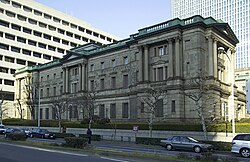Monetary policy
Monetary policy is the policy used by the monetary authority of a country that controls either the interest rate that can be paid on very short-term borrowing or the money supply. They often target inflation or the interest rate to help make price stability and general trust in the currency.[1][2][3]
Other goals of a monetary policy are usually to help make the gross domestic product more stable, to get and keep low unemployment, and to have predictable exchange rates with other currencies.
Monetary Policy Media
Banknotes with a face value of 5000 in different currencies (United States dollar, Central African CFA franc, Japanese yen, Italian lira, and French franc)
Reproduction of a Song dynasty note, possibly a Jiaozi, redeemable for 770 mò
2016 meeting of the Federal Open Market Committee at the Eccles Building, Washington, D.C.
1979 $10,000 United States Treasury bond
A run on a Bank of East Asia branch in Hong Kong, caused by "malicious rumours" in 2008
Gold certificates were used as paper currency in the United States from 1882 to 1933. These certificates were freely convertible into gold coins.
The Bank of Japan, in Tokyo, established in 1882
The Bank of Finland, in Helsinki, established in 1812
References
- ↑ Jahan, Sarwat. "Inflation Targeting: Holding the Line". International Monetary Funds, Finance & Development. Retrieved 28 December 2014.
- ↑ Monetary Policy. Federal Reserve Board. January 3, 2006. http://www.federalreserve.gov/policy.htm.
- ↑ Levy Yeyati, Eduardo; Sturzenegger, Federico (2010). "Monetary and Exchange Rate Policies". Handbooks in Economics. Handbook of Development Economics. Vol. 5. pp. 4215–4281. doi:10.1016/B978-0-444-52944-2.00002-1. ISBN 9780444529442.









